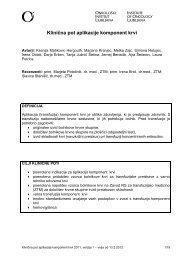Create successful ePaper yourself
Turn your PDF publications into a flip-book with our unique Google optimized e-Paper software.
Electrically-assisted delivery of siRNA targeting p53:<br />
an in vitro study on human tumor cell lines with<br />
different p53 status<br />
Suzana Mesojednik, Gregor Ser{a, Alenka Gro{el, Simona Kranjc, Gregor<br />
Tev`, Maja ^ema`ar<br />
Institute of Oncology, Department of Experimental Oncology, Zalo{ka 2, SI-1000 Ljubljana,<br />
Slovenia<br />
Background: Silencing of oncogenes or other genes contributing to tumor malignancy<br />
or progressson by 20–25- nucleotide dsRNA, better known as siRNA, offers a promising<br />
approach to treat tumors. High transfection efficiencies are of crucial importance for<br />
gene silencing experiments. Electroporation is currently receiving much attention as a<br />
way to increase siRNA delivery.<br />
Aim: The aim of our study was to determine the transfection efficiency and induction of<br />
siRNA-mediated silencing of p53 in two colorectal (HT-29 and LoVo) and two prostatic<br />
(PC-3 and DU145) carcinoma cell lines with different p53 status by varying voltage of<br />
electric pulses in in vitro electroporation protocol for siRNA transfection.<br />
Materials and methods: Two commercial plasmids (Invivogen) expressing siRNA<br />
were used, therapeutic (psiRNA-hp53 directed against the p53 mRNA) and control<br />
(psiRNA-GL3 directed against the luciferase mRNA). Both of them were, together with<br />
siRNA, expressing GFP, which allowed us to assess transfection efficiency. Plasmids<br />
were delivered to cells by electroporation. Mixture of cells (1 × 10 6 ) and plasmid<br />
(10 µg) as well as cells alone were exposed to eight square wave electric pulses<br />
(600 - 1000 V/cm, 5 ms, 1 Hz). Electric pulses were delivered through two parallel<br />
stainless steel plate electrodes with 2 mm distance between them and were generated<br />
by an electroporator GT-1. To qualitatively evaluate the siRNA effects against p53<br />
in different tumor cell lines with different p53 status the western blot analysis was<br />
performed. Cell survival after treatment was determined by clonogenic assay. GFP was<br />
detected by invert fluorescence microscopy.<br />
96p24<br />
Results: Transfection efficiency of electrically-assisted delivery of plasmids expressing<br />
siRNA varied depending on the cell line used and voltage of electric pulses applied.<br />
The optimal voltage of applied electric pulses were 700 V/cm for PC-3 and DU145<br />
cell lines and 900 V/cm for HT29 and LoVo cell lines which resulted in 10 - 40 %<br />
(PC-3), 1 - 9 % (DU145), 1 - 4 % (HT29 ) and 1 – 7 % (LoVo) transfection efficiency.<br />
The GFP expression was detected already at 6 hours after electroporation. It remained<br />
present during 1 week with a peak in fluorescence emission at day 1 or 2. Western blot<br />
analysis showed that siRNA directed against p53 mRNA resulted in up to 40% lower<br />
p53 protein level in Du145 (p53mt) cells. PC-3 (p53null) cells were negative control.<br />
In accordance with our expectation, no silencing of p53 mRNA by control siRNA was<br />
detected. Treatment of cells with electrically-assisted delivery of siRNA targeting p53<br />
did not result in reduced cell survival compared to the treatment with control siRNA.<br />
Conclusions: Our results showed that electroporation is feasible and effective method<br />
for delivering of siRNA to tumor cells. Electrically-assisted delivery of siRNA directed<br />
against p53 resulted in lower p53 protein content in cell lines used in this study but it<br />
did not reduce cell survival compared to the treatment with control siRNA.

















